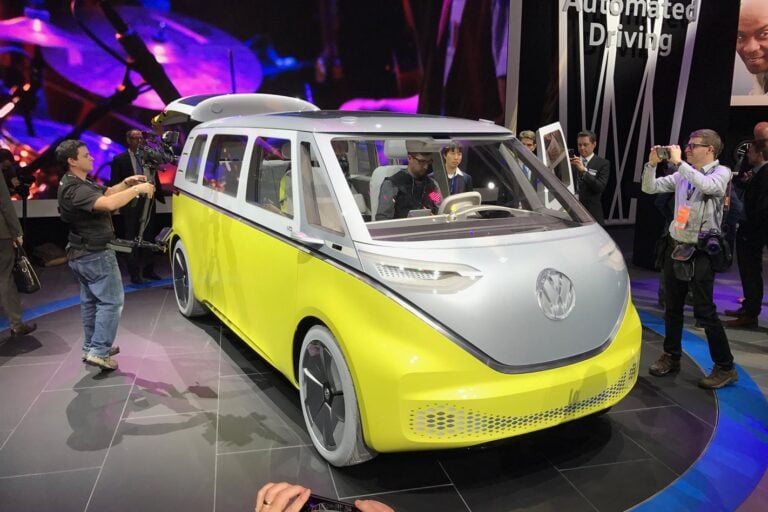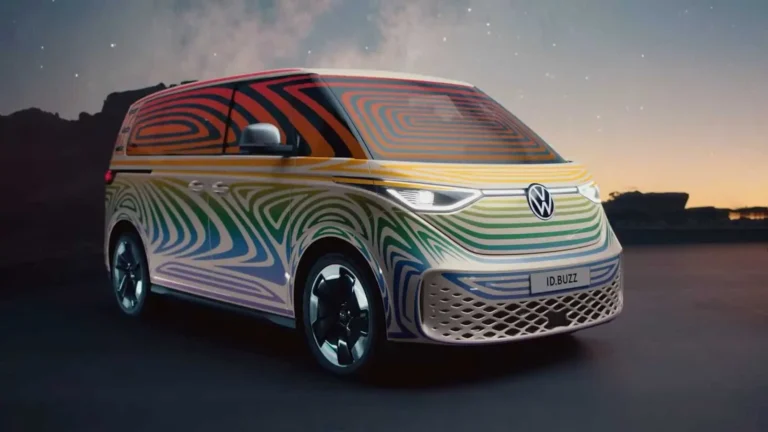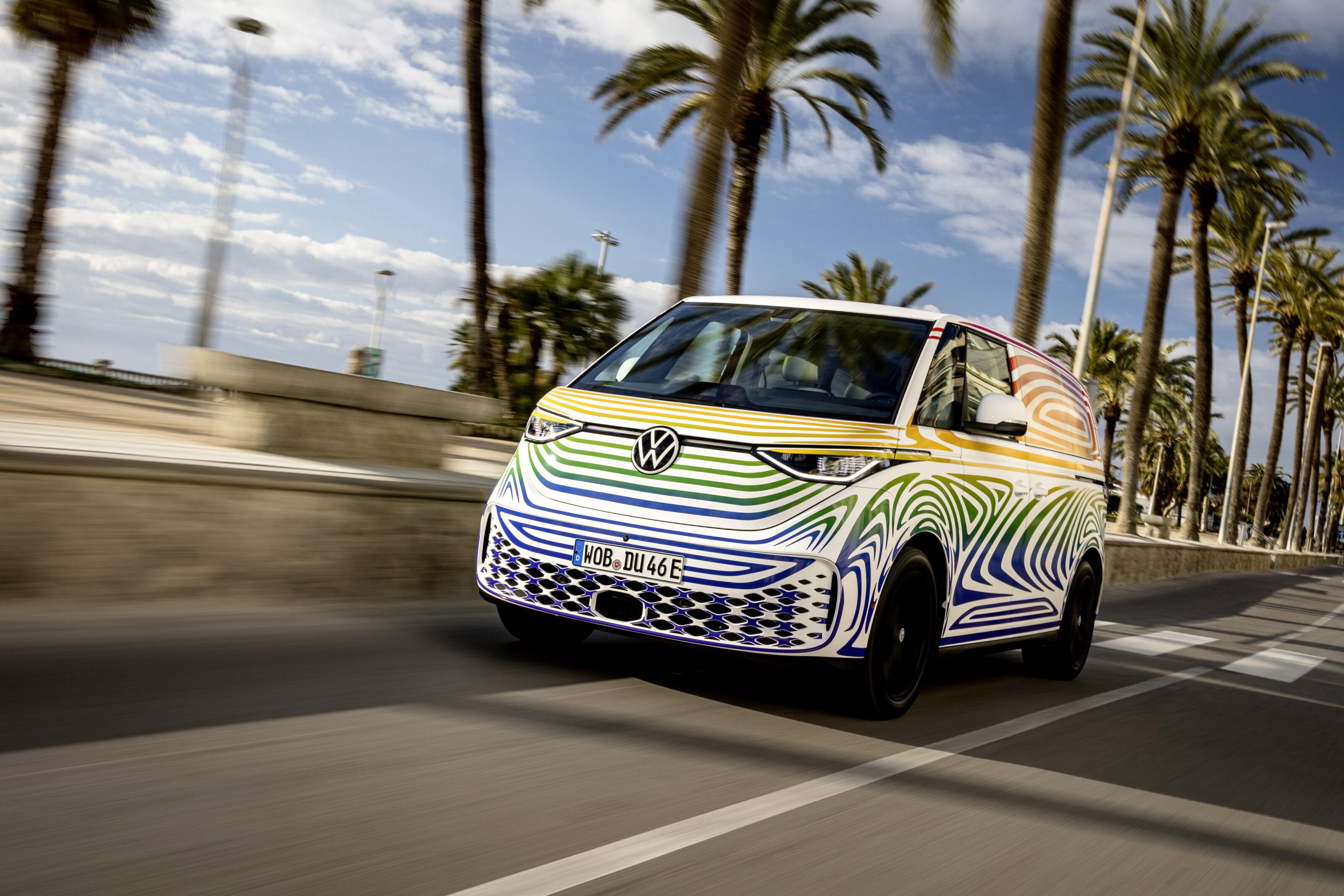Things we like
- Space
- Functionality
- Looks
Not so much
- Performance
- Ergonomics
- Weight
UPDATE, March 29 2023: Australian timing confirmed for ID models
Volkswagen Australia has today confirmed local launch timing for its ID.3, ID.4, ID.5 and ID.Buzz models – get all the details at the links below.
November 2022: ID.4 driven in Australia!
We’ve now had a chance to drive an overseas ID.4 car in Australia. Get our full story at the link below.
Story continues…
Be sure to wear flowers in your hair, or perhaps even don that wrinkled rainbow hippie outfit before taking the retro-futuristic electric Microbus for a ride when it arrives – optionally as a long-wheelbase people mover and cleverly packaged cargo van. (Although exact Australian plans are still to be confirmed.)
Designed with a sublime grasp of flair, style and tradition, the versatile low-drag 2023 Volkswagen ID.Buzz e-van shares more elements than expected with the 1950 classic. Its powerplant is again rear-mounted, driving the nearby wheels accompanied by subtle transformer whine.
In long-wheelbase guise, it seats up to seven passengers in reasonable comfort. The massive power-operated sliding doors create an even bigger aperture than the double side-hinged portals of yore, and the bright four-lite greenhouse mimics the original except for the optional dozen skylights.
Even the driving position – relatively close to the windscreen, throning on a pair of high-mounted captain’s chairs – evoke thoughts of the days of free love and psychedelic music.
UPDATE, Dec 15: ID Buzz comes to Australia
Volkswagen’s ID Buzz has been whisked into Australia for a quick tour, ahead of its local launch in the coming year. Join John Law for a look at its features and space.

Story continues…
The production version differs from the acclaimed concept in numerous areas. The roll-down windows are of course no longer flush-fitting, the black cast-iron hinges of the available split rear doors stick out of the Cargo model like two sore liquorice thumbs, the two-tone colour schemes and the contrasting material mix are a little too gaudy for such a classy design, and the ergonomic chaos pioneered by ID.3 hatch and ID.4 SUV was unfortunately passed on like a haptic virus to the ID.Buzz.
You still start the motor by pushing a button, but the gear selector which grows out of the steering column works to a modified yet no more intuitive pattern. The distant 12-inch touchscreen and the cursed touch sliders arranged below it still make the driver play index finger Bingo 24/7. Voice control is a useful option, except that all safety-related commands are off-limits.

By and large, design, packaging and functionality are spot-on. The only serious qualm is the poor visibility with regard to traffic lights and signs mounted more than a foot above the driver’s eye level. In Europe, leaning forward often solves the problem, but Americans used to single sky-high traffic signals overlooking the crossroads are bound to balk at this inconvenience. In contrast, it’s hard not to appreciate the roomy, bright and well-considered cabin.
The optional massage seats are first-class comfy, leg- and headroom is abundant in rows one and two, the split rear bench tilts flat and is easily adjustable in reach.
Folding all chairs from the B-posts back to the tailgate creates a wide, level and carpeted loading (or sleeping) area along with an additional underfloor storage cubicle. It’s a pragmatic arrangement, solid, rattle-free, properly trimmed and a breeze to use via two side-mounted levers. No surprise that VW is already looking at a fully electric Multivan tailor-made for tomorrow’s even more environmentally conscious nomads.
The ID.Buzz drives like a trucklet and car hybrid. For a start, the substantial kerb weight of 2.5 tonnes is an ever-present factor

The ID.Buzz will be available in standard- and long-wheelbase form. The base model is 200mm shorter and 12mm lower than the front-engined T6.1. It can thus enter parking structures with a height restriction of 1950mm without brushing the coiffure. While all Buzzes come with two sliding doors, only the kerbside swing-open device is standard on the Cargo version.
Also unique to the light commercial vehicle are the three-seat cabin, the fixed steel partition with or without window, and the comprehensive fastening equipment with eyes, rails, clips and whatnot.
The 1230mm clearance between the rear wheel houses enables the silent hauler to swallow two Euro pallets. While the Buzz can stash away up to 1121 litres of goods, the storage area of the LWB Big Cargo sister model measures an enormous four cubic metres. Lifting heavy stuff is made easy by the low loading sill which peaks at 623mm. The towing capacity works out at exactly one tonne.

The ID.Buzz drives like a trucklet and car hybrid. For a start, the substantial kerb weight of 2.5 tonnes is an ever-present factor. As a consequence, flooring the throttle at the lights does not have the typical kick-in-the-butt effect EVs have become famous for.
Although the instantly available maximum torque is a fairly generous 310Nm, the hand-stopped acceleration time from 0-62mph worked out at 9.8 seconds – that’s about 1.5sec slower than the ID 4 and on par with the T6.1 Multivan.
The ID.Buzz’s driving range between recharging stops is said to be in the area of 523 kilometres. While most ID models are good for a top speed of 160km/h, the battery-fed people mover is restricted to 145km/h.
The extra weight and the larger frontal area are also taking their toll in terms of overall efficiency, which is reflected by the observed energy consumption of 23.7kWh/100km – that’s not exactly brilliant in view of the recorded average speed of 62km/h. On the autobahn, 30kWh/100km (give or take a couple of digits) will therefore likely be the norm rather than the exception.
At an average charge speed of 125kW, it takes about 38 minutes to restore the SOC from five to 80 per cent, so make that a large cappuccino and treat yourself to a second donut.
No surprise that VW is already looking at a fully electric Multivan tailormade for tomorrow´s even more environmentally conscious nomads.

There are also a couple of upsides to the ID.Buzz’s weight, most obvious being the tarmac-hugging centre of gravity ensured by the heavy underfloor battery rated at 77kWh net. In combination with the long 2988mm wheelbase and the independent suspension all-round, the ID.Buzz professes a better than expected ride over long undulations, uneven patchwork surfaces, and level railway crossings.
Shod with 235/45 R21 rubber up front and even wider 255/40 R21 rear footwear, the well balanced overall compliance is repeatedly crushed by the tyres’ stiff sidewalls, the rigid high-speed rubber compound and the Yeti footprint. Adjustable shock absorbers are an option the test car was not fitted with; the same goes for the so-called Progressive Steering and the almost indispensable heat pump.
Worthwhile extras include adaptive IQ matrix headlights, Travel Assist with ACC, and Park Assist with memory. The latter feature remembers favourite parking spots and does its own multi-turn manoeuvring even if this means squeezing at an angle into super-tight lots or backing out of long, narrow and curvy access paths. Amazing, this.

The steering feels light but never vague, it is direct but not nervous, and it describes an extra-tight turning radius of under 11 metres which is exceptional for a 4712mm MPV.
The brakes – discs at one end, drums at the other – are keen on restoring energy, providing instant feedback and indulging in effortless repeat action. Unlike other previously driven IDs, this one decelerated progressively to a full stop without a noteworthy increase in pedal pressure. The more energetic of two brake energy recovery modes is calibrated to relay that one-pedal feel some love and others hate.
Alternatively, you can go with the flow and hope that the selected drive mode will engage Coast before the increasingly frustrated chauffeur reaches for the non-existing shift paddle – a classic missed opportunity.
Not surprisingly, the 150kW motor mated to a single-speed transmission fails to add a new chapter to The Great Electric Performance Revolution, but it does an okay job, predominantly in urban driving conditions.
Next year, VW will offer a smaller battery (52kWh for 305km of range) as well as bigger 111kWh unit which should be good for around 605km. Also in the works is a 4WD GTX edition rated at 223kW and an unchanged 310Nm.
There are upsides to the weight. Most obvious is the tarmac-hugging centre of gravity ensured by the underfloor battery. With the independent suspension, it professes a better than expected ride

Prices are typically released late in the game, and since this is a seller’s market due to strong demand and the persistent microchip shortage, the numbers are at this point more provisional than ever.
Accordingly to be taken with a pinch of salt are the 54,000 Euro estimate for the Cargo and the 49,000 Euro tag for the standard-wheelbase ID.Buzz, both before subsidies and other incentives. Add at least 15,000 Euro for a fully-loaded specimen, and 5000 Euro more for the limited First Edition. Sounds like a lot, yet seems to be the going rate for comparable SUVs and MPVs including high-end Chinese imports.
Looking deeper into the crystal ball, we can see a fully electric California camper based on a reinforced MEB platform, an all-new electric T8 Transporter co-developed with Ford and a fully autonomous Buzz which is due to join the self-driving Moia fleet in 2025 as a pivotal part of Volkswagen’s future on-demand mobility services campaign.
While Ford has allegedly agreed to buy 600,000 MEB component sets for its Cologne-built zero-emission Focus-size hatchback, VW is extending the production capacity of the Hannover plant to make room for 400,000 Buzz Cargos and 600,000 Buzz People over life cycle. From 2025 onwards, the MEB 2.0 architecture will be phased out step by step in favour of the even more flexible SSP (scalable systems platform) matrix.
We like this video
Things we like
- Space
- Functionality
- Looks
Not so much
- Performance
- Ergonomics
- Weight
We recommend
-
 Events
Events2017 Detroit Motor Show: Volkswagen ID Buzz revives Kombi styling
The classic VW Microbus is back with an electric soul at the Detroit Motor Show. This spiritual Volkswagen Kombi successor is called the ID Buzz.
-
 News
News2022 Volkswagen ID Buzz to be revealed on March 9
Toned down exterior will see the Buzz fall in line with the existing ID range





